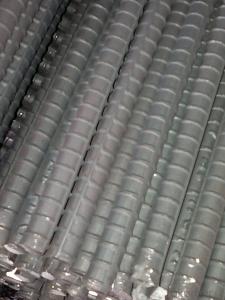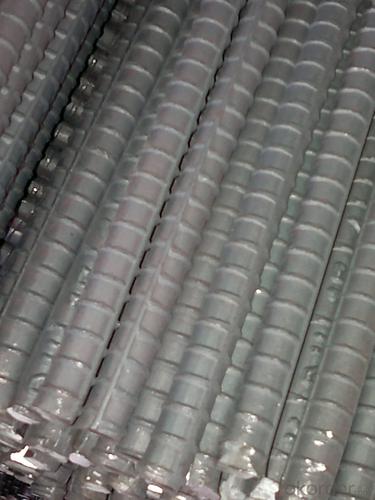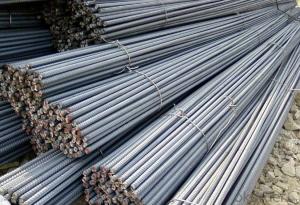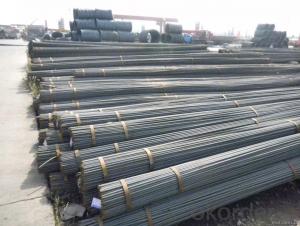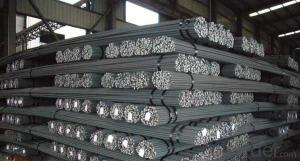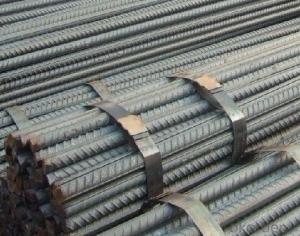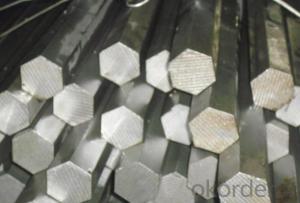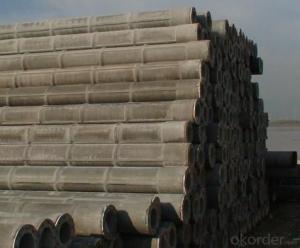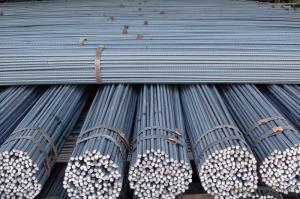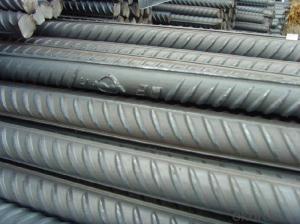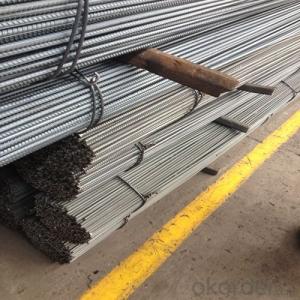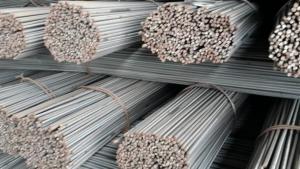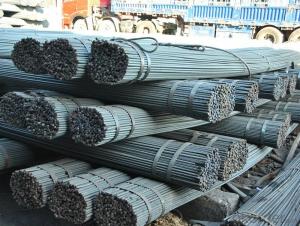Hot Rolled Steel Deformed steel bar rebar High Qulity
- Loading Port:
- Tianjin
- Payment Terms:
- TT or LC
- Min Order Qty:
- 1000 m.t.
- Supply Capability:
- 3500 m.t./month
OKorder Service Pledge
OKorder Financial Service
You Might Also Like
Product Description:
OKorder is offering Hot Rolled Steel Deformed steel bar rebar High Qulity at great prices with worldwide shipping. Our supplier is a world-class manufacturer of steel, with our products utilized the world over. OKorder annually supplies products to European, North American and Asian markets. We provide quotations within 24 hours of receiving an inquiry and guarantee competitive prices.
Product Applications:
Hot Rolled Steel Deformed steel bar rebar High Qulity In China are ideal for structural applications and are widely used in the construction of buildings and bridges, and the manufacturing, petrochemical, and transportation industries.
Product Advantages:
OKorder's Hot Rolled Steel Deformed steel bar rebar High Qulity are durable, strong, and resist corrosion.
Main Product Features:
· Premium quality
· Prompt delivery & seaworthy packing (30 days after receiving deposit)
· Corrosion resistance
· Can be recycled and reused
· Mill test certification
· Professional Service
· Competitive pricing
Product Specifications:
Standard | GB | HRB400 | |
Diameter | 6mm,8mm,10mm,12mm,14mm,16mm,18mm,20mm, 22mm,25mm,28mm,32mm,36mm,40mm,50mm | ||
Length | 6M, 9M,12M or as required | ||
Place of origin | Hebei, China mainland | ||
Advantages | exact size, regular package, chemical and mechanical properties are stable. | ||
Type | Hot rolled deformed steel bar | ||
Brand name | DRAGON | ||
Packaging & Delivery of Hot Rolled d-bar Steel
1. Packing: it is nude packed in bundles by steel wire rod
2. Bundle weight: not more than 3.5MT for bulk vessel; less than 3 MT for container load
3. Marks:
Color marking: There will be color marking on both end of the bundle for the cargo delivered by bulk vessel. That makes it easily to distinguish at the destination port.
Tag mark: there will be tag mark tied up on the bundles. The information usually including supplier logo and name, product name, made in China, shipping marks and other information request by the customer.
If loading by container the marking is not needed, but we will prepare it as customer request.
4. Transportation: the goods are delivered by truck from mill to loading port, the maximum quantity can be loaded is around 40MTs by each truck. If the order quantity cannot reach the full truck loaded, the transportation cost per ton will be little higher than full load.
5. Delivered by container or bulk vessel
FAQ:
Q1: Why buy Materials & Equipment from OKorder.com?
A1: All products offered byOKorder.com are carefully selected from China's most reliable manufacturing enterprises. Through its ISO certifications, OKorder.com adheres to the highest standards and a commitment to supply chain safety and customer satisfaction.
Q2: How do we guarantee the quality of our products?
A2: We have established an advanced quality management system which conducts strict quality tests at every step, from raw materials to the final product. At the same time, we provide extensive follow-up service assurances as required.
Q3: How soon can we receive the product after purchase?
A3: Within three days of placing an order, we will begin production. The specific shipping date is dependent upon international and government factors, but is typically 7 to 10 workdays.
Q4: What makes stainless steel stainless?
A4: Stainless steel must contain at least 10.5 % chromium. It is this element that reacts with the oxygen in the air to form a complex chrome-oxide surface layer that is invisible but strong enough to prevent further oxygen from "staining" (rusting) the surface. Higher levels of chromium and the addition of other alloying elements such as nickel and molybdenum enhance this surface layer and improve the corrosion resistance of the stainless material.
Q5: Can stainless steel rust?
A5: Stainless does not "rust" as you think of regular steel rusting with a red oxide on the surface that flakes off. If you see red rust it is probably due to some iron particles that have contaminated the surface of the stainless steel and it is these iron particles that are rusting. Look at the source of the rusting and see if you can remove it from the surface.
Images:
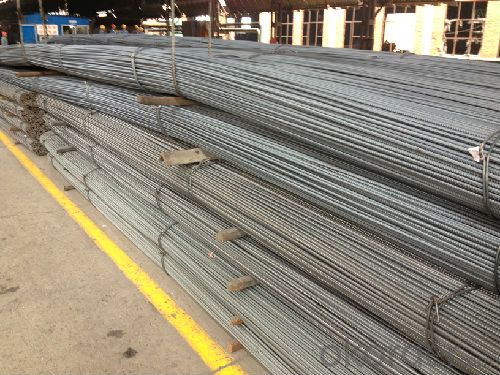
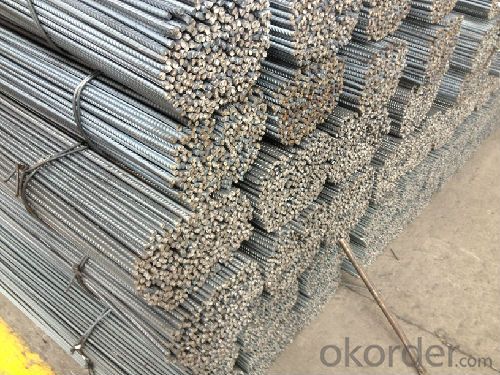
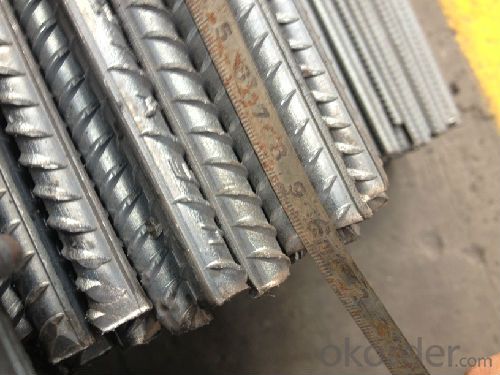
- Q: What is the impact of steel rebars on the carbon footprint of a building?
- Steel rebars have a significant impact on the carbon footprint of a building due to their production process and overall lifecycle. The manufacturing of steel rebars involves the extraction of raw materials, such as iron ore, and the energy-intensive process of smelting and refining them into steel. This phase alone contributes to greenhouse gas emissions and consumes substantial amounts of energy. Additionally, the transportation and construction of steel rebars also contribute to the carbon footprint of a building. The transportation process involves the use of fossil fuels, which release carbon dioxide into the atmosphere. Furthermore, the construction phase requires heavy machinery and equipment, which also rely on fossil fuels, further adding to the carbon emissions. Moreover, the carbon footprint of steel rebars extends beyond the construction phase. Steel is highly durable and can last for decades, but it also requires maintenance and potential replacement over time. These activities, such as repairs or demolitions, incur additional carbon emissions due to transportation, energy consumption, and waste management. However, it is important to note that steel rebars can offer environmental benefits when used in high-performance buildings or sustainable construction practices. For instance, steel is recyclable, and reusing steel rebars can significantly reduce the carbon footprint associated with their production. Additionally, steel rebars provide structural strength, allowing for the construction of taller and more efficient buildings that can potentially reduce energy consumption in the long run. To minimize the carbon footprint of a building, it is essential to consider alternative materials, such as recycled steel or other low-carbon materials, in the construction process. Additionally, implementing energy-efficient practices throughout the building's lifecycle, including reduced energy consumption and improved waste management, can further mitigate the environmental impact of steel rebars.
- Q: What are the different types of steel rebars used in underground constructions?
- There are several types of steel rebars used in underground constructions, including epoxy-coated rebars, stainless steel rebars, and galvanized rebars. These different types of rebars offer various benefits such as increased corrosion resistance, improved durability, and enhanced structural strength, making them suitable for different underground applications.
- Q: Can steel rebars be used in retaining walls?
- Yes, steel rebars can be used in retaining walls. Steel rebars are commonly used in the construction of retaining walls to provide reinforcement and increase the structural integrity of the wall. They help to prevent cracking and ensure the wall can withstand lateral pressure from the retained soil or other materials.
- Q: How do steel rebars provide reinforcement to concrete?
- Concrete is reinforced by steel rebars, which act as tension members. When loads are applied to the concrete, such as the weight of a structure or external forces, it tends to crack and fail under tension. To counteract this weakness, steel rebars are embedded within the concrete. Made of high-strength steel, the rebars have a much higher tensile strength than concrete. During the pouring of concrete, the rebars are strategically placed throughout the structure, typically in areas where tension forces are expected. These areas include beams, columns, and slabs. As the concrete cures and hardens, it forms a strong bond with the steel rebars. When external forces are exerted on the concrete, like the weight of a building or lateral forces from wind or earthquakes, tension forces are generated within the concrete. However, instead of causing the concrete to crack and fail, the rebars bear the majority of the tension. Due to the high tensile strength of the steel rebars, they can resist the tension forces, preventing the formation of cracks and ensuring the integrity and structure of the concrete. The rebars act as reinforcement by evenly distributing the tensile forces throughout the concrete, enhancing its overall strength and durability. Moreover, rebars offer additional benefits to concrete structures. They can mitigate the effects of temperature changes, prevent shrinkage cracks, and enhance resistance to corrosion caused by environmental factors. In conclusion, the use of steel rebars significantly improves the structural integrity and lifespan of concrete, enabling it to withstand various loads and external forces over time.
- Q: What are the different shapes of steel rebars?
- The different shapes of steel rebars include plain round bars, deformed bars, square bars, and rectangular bars.
- Q: What are the guidelines for proper spacing and lapping of steel rebars in concrete structures?
- The guidelines for proper spacing and lapping of steel rebars in concrete structures vary depending on the specific design and structural requirements. However, some general recommendations exist. The rebars should be adequately spaced to ensure proper concrete cover, allowing for corrosion protection and sufficient bond strength. Typically, the minimum spacing between parallel rebars is around 1.5 times the diameter of the larger bar or 25 mm (1 inch), whichever is greater. Lapping, or overlapping, of rebars is necessary to create a continuous load path. The length of the overlap depends on the design and the type of rebar connection being used. It is important to follow the specifications provided by structural engineers and adhere to local building codes to ensure the proper spacing and lapping of rebars in concrete structures.
- Q: What are the guidelines for proper tying of steel rebars in concrete structures?
- The guidelines for the proper tying of steel rebars in concrete structures are crucial to ensure the structural integrity and durability of the construction. Here are some important guidelines to follow: 1. Rebar Placement: Prior to tying, ensure that the rebars are accurately positioned as per the structural drawings and design specifications. The rebars should be placed at the designated locations, depths, and with proper spacing to provide the required strength and reinforcement. 2. Tying Tools: Use appropriate tools such as pliers or rebar tying machines to ensure proper and secure tying. The tools should be in good condition and suitable for the size and type of rebars being used. 3. Tying Technique: Adopt a consistent and efficient tying technique. Start by securely holding the rebars together at the intersection point. Wrap the tie wire around both rebars multiple times, ensuring tight and firm connections. The tie wire should be properly twisted and cut neatly to avoid any protrusions. 4. Tie Wire Selection: Use high-quality tie wires with sufficient strength to withstand the tension and load requirements. The tie wire should be corrosion-resistant, typically made of galvanized steel or stainless steel, to prevent rusting and deterioration over time. 5. Tying Spacing: Follow the specified tying spacing as per the design requirements. Adequate spacing between ties helps maintain the rebars in their designated positions and prevents any displacement during concrete pouring and subsequent curing. 6. Tying Quantity: Tie rebars at appropriate intervals to ensure sufficient connection and reinforcement. The number of ties required will depend on the size, shape, and length of the rebars used, as well as the structural design specifications. 7. Tying Consistency: Maintain consistency in tying throughout the entire concrete structure. Uneven or inconsistent tying can lead to weak points, reduced reinforcement, and compromised structural integrity. 8. Tying Safety: Always prioritize safety during the tying process. Wear appropriate personal protective equipment (PPE) such as gloves and safety glasses to protect against injuries. Take precautions to avoid tripping hazards and ensure a safe working environment. 9. Inspection and Quality Control: Regularly inspect the tied rebars to ensure compliance with design specifications and quality standards. Conduct visual inspections and perform pull tests to assess the strength and effectiveness of the ties. 10. Compliance with Codes and Standards: Adhere to local building codes, industry standards, and engineering guidelines specific to your region. These codes provide essential requirements for rebar tying, ensuring the durability and safety of the concrete structure. By following these guidelines, construction professionals can ensure the proper tying of steel rebars in concrete structures, improving their strength, stability, and longevity.
- Q: What is the minimum lap length required for steel rebars in concrete?
- The minimum lap length required for steel rebars in concrete is typically specified by engineering codes and standards, which vary depending on factors such as the type of rebar, the diameter of the rebar, and the intended structural design. It is important to consult the specific code or standard relevant to the project to determine the minimum lap length requirements.
- Q: How are steel rebars tested for quality?
- Steel rebars are typically tested for quality through various methods such as visual inspection, dimensional checks, and destructive/non-destructive testing. Visual inspection involves examining the surface for any visible defects or irregularities. Dimensional checks ensure that the rebars meet the specified size and length requirements. Destructive testing involves conducting mechanical tests to measure the strength, ductility, and other properties of the rebars, while non-destructive testing methods like ultrasonic testing or magnetic particle inspection are used to detect internal defects without damaging the rebars. These quality tests help ensure that the steel rebars meet the required standards and are safe for use in construction projects.
- Q: What is the recommended maximum length of cantilevered steel rebars?
- The recommended maximum length of cantilevered steel rebars is typically limited to 40 times the diameter of the rebar, as per industry standards and structural design guidelines.
Send your message to us
Hot Rolled Steel Deformed steel bar rebar High Qulity
- Loading Port:
- Tianjin
- Payment Terms:
- TT or LC
- Min Order Qty:
- 1000 m.t.
- Supply Capability:
- 3500 m.t./month
OKorder Service Pledge
OKorder Financial Service
Similar products
Hot products
Hot Searches
Related keywords
